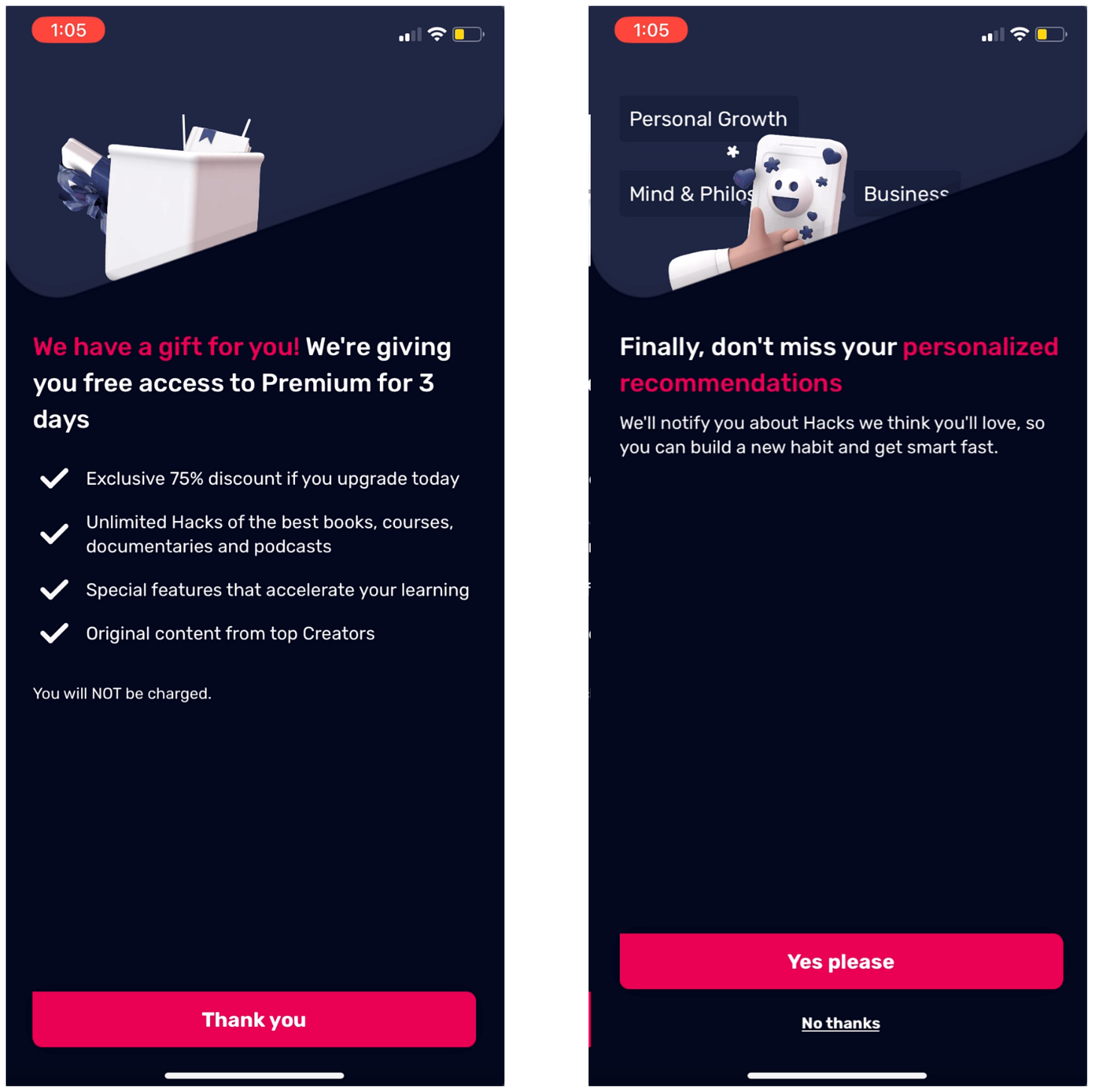Are you confident in your product?
Test out a reverse trial.
Hey there, it’s Jacob at Retention.Blog 👋
I got tired of reading high-level strategy articles, so I started writing actionable advice I would want to read.
Every week I share practical learnings you can apply to your business.
What’s a reverse trial?
A reverse trial is a trial that doesn’t automatically renew.
The app gives you access to premium features without entering payment info.
This can be a great tactic if you’re confident in the value and quality of your product.
Why?
Because you get most new users trying your premium features vs the normal 10-20% of users starting a trial.
Do you think your product experience is strong enough to captivate people to pay for your app after their free access expires?
It’s risky because people’s intent and excitement are highest when they first download the app.
But if you make it work, you get waaay more people to actually experience the value of the premium.
What are a few different ways you can implement a reverse trial?
Let’s start with Ladder.
Ladder is a fitness app that partners with fitness influencers to create high-quality semi-personalized workouts.
They captivate you early on with their in-depth video content of the workout coach. This shows the quality of their coaches and app. (The video is a little long for me, but clearly it works)
First, you select your “Team” which is the coach you want workouts from.
After you select your coach, you watch a little video, and then they opt you into the reverse trial.
Interesting that they still use the blinkest trial timeline paywall style.
How do they make it work?
One of the tactics is making users complete the “Welcome Workout” to unlock the rest of the app.
Activation is always a huge challenge and one of the most important things to drive long-term retention and usage.
I really like how Ladder makes you complete a workout to see everything else.
They continue to use this tactic by rewarding your completed workouts with more unlocked content and features.
Ladder made $1M in May on only 90k downloads, so they must be doing something right!
This reminded me a little of Impulse’s rewarded onboarding flow. In practice, it’s very different, but the user psychology is similar of incentivizing users to continue and try the first activity.
Don’t want to give up on your standard trial so easily?
The Uptime app uses a standard trial at first, but then uses a 72-hour reverse trial as their secondary offer.
They position it as a gift for you.
I would like to have seen Uptime use more tactics like Ladder to drive early engagement.
If you give Premium features away for free, people aren’t going to value them as much.
You need to strike the right balance between getting users to try your premium features and creating a little friction to make sure they appreciate the feature
Depending on your product type, this may not be the right approach.
Flightly is the ultimate flight tracker app.
They offer a reverse trial in the form of “complimentary Flightly Pro for your first flight”
This is a cool way to approach a trial because you may not have a flight in the next 7 days.
If you have an app tied to a real-world use case, there are many variables that may get in the way of someone trying your product with a standard trial.
I could see this “free first use case” making sense for other products.
How many times have you started a trial for something, forgotten to use it, then canceled the trial without ever trying the product?
If you’re like me, quite a few times.
Your ultimate goal with a trial should be to get people to try your premium features, and then like your product enough they want to pay.
A reverse trial gets the most people to access your premium content.
This tactic won’t be great for every product, but it’s worth a try.
I don’t think you should expect to be able to switch to a reverse trial without changing anything else in your product and see good results.
You need to change the new user experience, so that:
Users are very aware that they’re accessing premium features
You have strong engagement hooks early in the experience
You actually have a valuable product people want to use (I guess that’s bigger than just the new user experience…)
Are all of these good tactics for regular trial as well? Of course, but they seem even more important to me for a reverse trial.
Ultimately, you need to get users excited enough about the early experience to go out of their way to pay and not just fade away.
Check out the Whimsical board here to see all my research
📣 Want to help support and spread the word?
Go to my LinkedIn here and like, comment, or share my post.
OR
Share this newsletter by clicking here.












I don't feel like Uptime is making it super clear that there this is not a "normal" trial and no credit card is required
Thanks for writing this. I came across this a few weeks ago when I was going to go the normal trial route with my newest app but I changed my mind after reading. I like how much friction this removes from the experience.
I don’t want to spam your comments with a link to my app (happy to send if you’re curious) but I did want to say thanks because it really did change the direction of my approach!